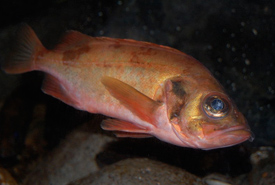
Acadian redfish (Photo by Steven G. Johnson)
Acadian redfish
Also known as Atlantic redfish, Acadian redfish are named for their bright, red-to-orange-coloured scales.
What does it look like?
In addition to their vivid colours, Acadian redfish have spiny rays along their dorsal (top) and bottom fins. They have a protruding lower jaw and bony spines covering their gills. In comparison to their body size, they have large eyes, which are often yellow in colour.
Where does it live?
In Canada, Acadian redfish occur in deep Atlantic waters. They live in continental slopes in water ranging from 150 to 300 metres deep. There are two populations of Acadian redfish: Atlantic and Bonne Bay. The Atlantic population has been known to frequent waters as far north as Baffin Island, Nunavut, and as south as the Gulf of St. Lawrence.
Life in the slow lane
Acadian redfish develop slower than most fish, reaching sexual maturity at five to 12 years. They have a long lifespan, with some individuals living up to 75 years in the wild.
This species is ovoviviparous, meaning they do not lay eggs. Instead, female Acadian redfish keep fertilized eggs inside of them. The offspring are released once they hatched into larvae. While adults prefer deep waters, larvae remain near the surface to feed on fish eggs and small crustaceans.
What is this species’ conservation status?
This species’ population has declined significantly due to fishing and bycatch. It is estimated that populations have declined nearly 99 per cent since the late 1970s. However, populations on the Scotian Shelf in Nova Scotia appear to have remained stable.
In 2010, the Committee on the Status of Endangered Wildlife in Canada assessed the Atlantic population of Acadian redfish as threatened.





